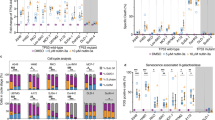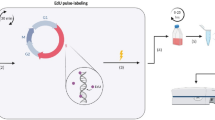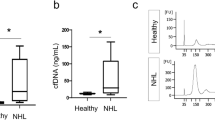Abstract
Phosphorylation of histone protein H2AX on serine 139 (gamma-H2AX) occurs at sites flanking DNA double-stranded breaks (DSBs) and can provide a measure of the number of DSBs within a cell. We describe a flow cytometry-based method optimized to measure gamma-H2AX in nonfixed mononuclear blood cells as well as in cultured cells, which is more sensitive and involves less steps compared with protocols involving fixed cells. This method can be used to monitor induction of gamma-H2AX in mononuclear cells from cancer patients undergoing radiotherapy and for detection of gamma-H2AX throughout the cell cycle in cultured cells. The method is based on the fact that H2AX like other histone proteins are retained in the nucleus when cells are lysed at physiological salt concentrations. Cells are therefore added without fixation to a solution containing detergent to lyse the cells along with a fluorescein isothiocyanate-labeled monoclonal gamma-H2AX antibody, DNA staining dye and blocking agents. The stained nuclei can be analyzed by flow cytometry to monitor the level of gamma-H2AX to determine the level of DSBs and DNA content and to determine the cell cycle stage. The omission of fixation simplifies staining and enhances the sensitivity. This protocol can be completed within 4–6 h.
This is a preview of subscription content, access via your institution
Access options
Subscribe to this journal
Receive 12 print issues and online access
$259.00 per year
only $21.58 per issue
Buy this article
- Purchase on Springer Link
- Instant access to full article PDF
Prices may be subject to local taxes which are calculated during checkout




Similar content being viewed by others
References
Tounekti, O. et al. The ratio of single- to double-strand DNA breaks and their absolute values determine cell death pathway. Br. J. Cancer 84, 1272–1279 (2001).
Blocher, D. In CHEF electrophoresis a linear induction of dsb corresponds to a nonlinear fraction of extracted DNA with dose. Int. J. Radiat. Biol. 57, 7–12 (1990).
Chen, C.Z. & Sutherland, J.C. Gel electrophoresis method for quantitation of gamma ray induced single- and double-strand breaks in DNA irradiated in vitro. Electrophoresis 10, 318–326 (1989).
Wlodek, D., Banath, J. & Olive, P.L. Comparison between pulsed-field and constant-field gel electrophoresis for measurement of DNA double-strand breaks in irradiated Chinese hamster ovary cells. Int. J. Radiat. Biol. 60, 779–790 (1991).
Gradzka, I. & Iwanenko, T. A non-radioactive, PFGE-based assay for low levels of DNA double-strand breaks in mammalian cells. DNA Repair 4, 1129–1139 (2005).
Collins, A.R. The comet assay for DNA damage and repair: principles, applications, and limitations. Mol. Biotechnol. 26, 249–261 (2004).
Olive, P.L. et al. The comet assay in clinical practice. Acta. Oncol. 38, 839–844 (1999).
Ostling, O. & Johanson, K.J. Microelectrophoretic study of radiation-induced DNA damages in individual mammalian cells. Biochem. Biophys. Res. Commun. 123, 291–298 (1984).
Ahnström, G. & Erixon, K. Measurement of strand breaks by alkaline denaturation and hydroxyapatite chromatography. in DNA Repair (eds. Friedberg, E.C. & Hanawalt, P.C.) 403–418 (Marcel Dekker Inc., New York, 1980).
Burma, S. et al. ATM phosphorylates histone H2AX in response to DNA double-strand breaks. J. Biol. Chem. 276, 42462–42467 (2002).
Rogakou, E.P. et al. DNA double-stranded breaks induce histone H2AX phosphorylation on serine 139. J. Biol. Chem. 273, 5858–5868 (1998).
Chen, H.T. et al. Response to RAG-mediated VDJ cleavage by NBS1 and gamma-H2AX. Science 290, 1962–1965 (2000).
Stiff, T. et al. ATM and DNA-PK function redundantly to phosphorylate H2AX after exposure to ionizing radiation. Cancer Res. 64, 2390–2396 (2004).
Paull, T.T. et al. A critical role for histone H2AX in recruitment of repair factors to nuclear foci after DNA damage. Curr. Biol. 10, 886–895 (2000).
Furuta, T. et al. Phosphorylation of histone H2AX and activation of Mre11, Rad50, and Nbs1 in response to replication-dependent DNA double-strand breaks induced by mammalian DNA topoisomerase I cleavage complexes. J. Biol. Chem. 278, 20303–20312 (2003).
Ward, I.M. & Chen, J. Histone H2AX is phosphorylated in an ATR-dependent manner in response to replicational stress. J. Biol. Chem. 276, 47759–47762 (2001).
Ward, I.M., Minn, K. & Chen, J. UV-induced ataxia-telangiectasia-mutated and Rad3-related (ATR) activation requires replication stress. J. Biol. Chem. 279, 9677–9680 (2004).
Pilch, D.R. et al. Characteristics of gamma-H2AX foci at DNA double-strand breaks sites. Biochem. Cell Biol. 81, 123–129 (2003).
Rothkamm, K. & Lobrich, M. Evidence for a lack of DNA double-strand break repair in human cells exposed to very low X-ray doses. Proc. Natl. Acad. Sci. USA 100, 5057–5062 (2003).
Sedelnikova, O.A. et al. Quantitative detection of (125)IdU-induced DNA double-strand breaks with gamma-H2AX antibody. Radiat. Res. 158, 486–492 (2002).
Olive, P.L. Detection of DNA damage in individual cells by analysis of histone H2AX phosphorylation. Methods Cell Biol. 75, 355–373 (2004).
Banath, J.P. & Olive, P.L. Expression of phosphorylated histone H2AX as a surrogate of cell killing by drugs that create DNA double-strand breaks. Cancer Res. 63, 4347–4350 (2003).
MacPhail, S.H. et al. Expression of phosphorylated histone H2AX in cultured cell lines following exposure to X-rays. Int. J. Radiat. Biol. 79, 351–358 (2003).
Olive, P.L. & Banath, J.P. Phosphorylation of histone H2AX as a measure of radiosensitivity. Int. J. Radiat. Oncol. Biol. Phys. 58, 331–335 (2004).
Hamasaki, K. et al. Short-term culture and gammaH2AX flow cytometry determine differences in individual radiosensitivity in human peripheral T lymphocytes. Environ. Mol. Mutagen 48, 38–47 (2007).
Huang, X. & Darzynkiewicz, Z. Cytometric assessment of histone H2AX phosphorylation: a reporter of DNA damage. Methods Mol. Biol. 314, 73–80 (2006).
Ismail, I.H., Wadhra, T.I. & Hammarsten, O. An optimized method for detecting gamma-H2AX in blood cells reveals a significant interindividual variation in the gamma-H2AX response among humans. Nucleic Acids Res. 35, e36 (2007).
Author information
Authors and Affiliations
Corresponding author
Rights and permissions
About this article
Cite this article
Muslimovic, A., Ismail, I., Gao, Y. et al. An optimized method for measurement of gamma-H2AX in blood mononuclear and cultured cells. Nat Protoc 3, 1187–1193 (2008). https://doi.org/10.1038/nprot.2008.93
Published:
Issue Date:
DOI: https://doi.org/10.1038/nprot.2008.93
This article is cited by
-
Clinical measurement of cellular DNA damage hypersensitivity in patients with DNA repair defects
Orphanet Journal of Rare Diseases (2022)
-
Biomarkers of DNA Damage Response Enable Flow Cytometry-Based Diagnostic to Identify Inborn DNA Repair Defects in Primary Immunodeficiencies
Journal of Clinical Immunology (2022)
-
γ-H2AX foci as indication for the DNA damage in erythrocytes of medaka (Oryzias latipes) intoxicated with 4-nonylphenol
Environmental Science and Pollution Research (2020)
-
Improved identification of DNA double strand breaks: γ-H2AX-epitope visualization by confocal microscopy and 3D reconstructed images
Radiation and Environmental Biophysics (2019)
-
Absence of DNA double-strand breaks in human peripheral blood mononuclear cells after 3 Tesla magnetic resonance imaging assessed by γH2AX flow cytometry
European Radiology (2018)
Comments
By submitting a comment you agree to abide by our Terms and Community Guidelines. If you find something abusive or that does not comply with our terms or guidelines please flag it as inappropriate.



